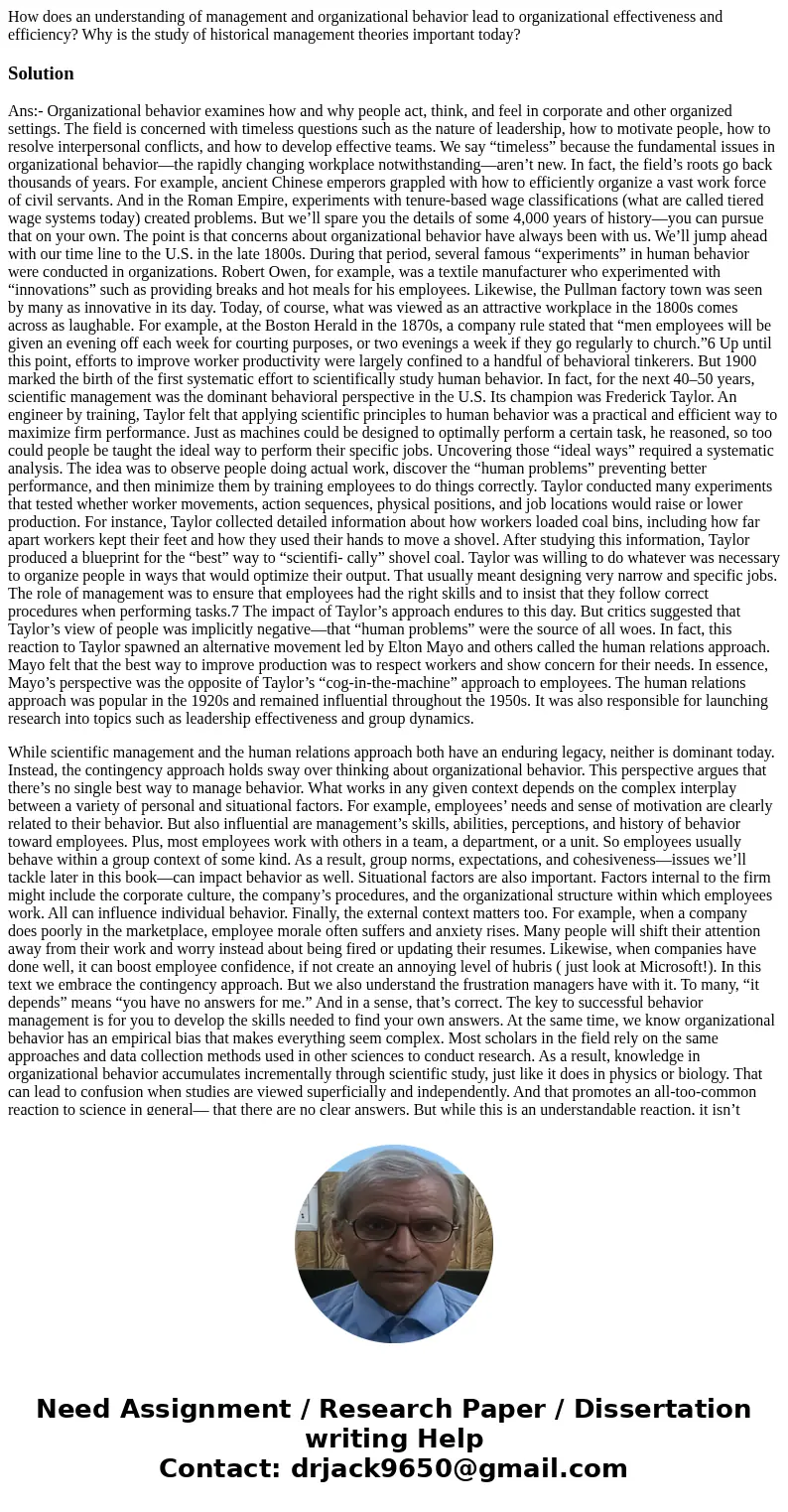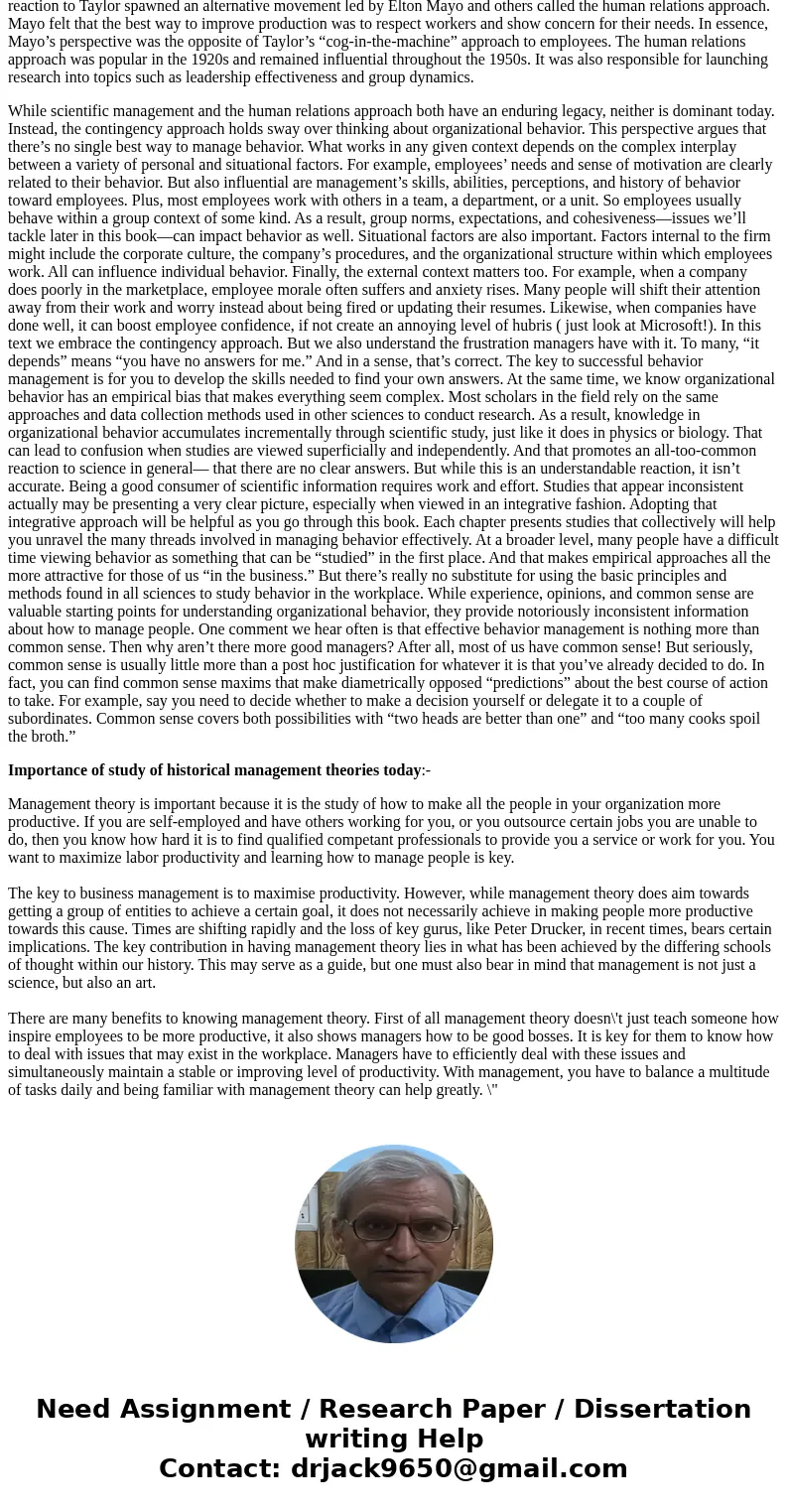How does an understanding of management and organizational b
How does an understanding of management and organizational behavior lead to organizational effectiveness and efficiency? Why is the study of historical management theories important today?
Solution
Ans:- Organizational behavior examines how and why people act, think, and feel in corporate and other organized settings. The field is concerned with timeless questions such as the nature of leadership, how to motivate people, how to resolve interpersonal conflicts, and how to develop effective teams. We say “timeless” because the fundamental issues in organizational behavior—the rapidly changing workplace notwithstanding—aren’t new. In fact, the field’s roots go back thousands of years. For example, ancient Chinese emperors grappled with how to efficiently organize a vast work force of civil servants. And in the Roman Empire, experiments with tenure-based wage classifications (what are called tiered wage systems today) created problems. But we’ll spare you the details of some 4,000 years of history—you can pursue that on your own. The point is that concerns about organizational behavior have always been with us. We’ll jump ahead with our time line to the U.S. in the late 1800s. During that period, several famous “experiments” in human behavior were conducted in organizations. Robert Owen, for example, was a textile manufacturer who experimented with “innovations” such as providing breaks and hot meals for his employees. Likewise, the Pullman factory town was seen by many as innovative in its day. Today, of course, what was viewed as an attractive workplace in the 1800s comes across as laughable. For example, at the Boston Herald in the 1870s, a company rule stated that “men employees will be given an evening off each week for courting purposes, or two evenings a week if they go regularly to church.”6 Up until this point, efforts to improve worker productivity were largely confined to a handful of behavioral tinkerers. But 1900 marked the birth of the first systematic effort to scientifically study human behavior. In fact, for the next 40–50 years, scientific management was the dominant behavioral perspective in the U.S. Its champion was Frederick Taylor. An engineer by training, Taylor felt that applying scientific principles to human behavior was a practical and efficient way to maximize firm performance. Just as machines could be designed to optimally perform a certain task, he reasoned, so too could people be taught the ideal way to perform their specific jobs. Uncovering those “ideal ways” required a systematic analysis. The idea was to observe people doing actual work, discover the “human problems” preventing better performance, and then minimize them by training employees to do things correctly. Taylor conducted many experiments that tested whether worker movements, action sequences, physical positions, and job locations would raise or lower production. For instance, Taylor collected detailed information about how workers loaded coal bins, including how far apart workers kept their feet and how they used their hands to move a shovel. After studying this information, Taylor produced a blueprint for the “best” way to “scientifi- cally” shovel coal. Taylor was willing to do whatever was necessary to organize people in ways that would optimize their output. That usually meant designing very narrow and specific jobs. The role of management was to ensure that employees had the right skills and to insist that they follow correct procedures when performing tasks.7 The impact of Taylor’s approach endures to this day. But critics suggested that Taylor’s view of people was implicitly negative—that “human problems” were the source of all woes. In fact, this reaction to Taylor spawned an alternative movement led by Elton Mayo and others called the human relations approach. Mayo felt that the best way to improve production was to respect workers and show concern for their needs. In essence, Mayo’s perspective was the opposite of Taylor’s “cog-in-the-machine” approach to employees. The human relations approach was popular in the 1920s and remained influential throughout the 1950s. It was also responsible for launching research into topics such as leadership effectiveness and group dynamics.
While scientific management and the human relations approach both have an enduring legacy, neither is dominant today. Instead, the contingency approach holds sway over thinking about organizational behavior. This perspective argues that there’s no single best way to manage behavior. What works in any given context depends on the complex interplay between a variety of personal and situational factors. For example, employees’ needs and sense of motivation are clearly related to their behavior. But also influential are management’s skills, abilities, perceptions, and history of behavior toward employees. Plus, most employees work with others in a team, a department, or a unit. So employees usually behave within a group context of some kind. As a result, group norms, expectations, and cohesiveness—issues we’ll tackle later in this book—can impact behavior as well. Situational factors are also important. Factors internal to the firm might include the corporate culture, the company’s procedures, and the organizational structure within which employees work. All can influence individual behavior. Finally, the external context matters too. For example, when a company does poorly in the marketplace, employee morale often suffers and anxiety rises. Many people will shift their attention away from their work and worry instead about being fired or updating their resumes. Likewise, when companies have done well, it can boost employee confidence, if not create an annoying level of hubris ( just look at Microsoft!). In this text we embrace the contingency approach. But we also understand the frustration managers have with it. To many, “it depends” means “you have no answers for me.” And in a sense, that’s correct. The key to successful behavior management is for you to develop the skills needed to find your own answers. At the same time, we know organizational behavior has an empirical bias that makes everything seem complex. Most scholars in the field rely on the same approaches and data collection methods used in other sciences to conduct research. As a result, knowledge in organizational behavior accumulates incrementally through scientific study, just like it does in physics or biology. That can lead to confusion when studies are viewed superficially and independently. And that promotes an all-too-common reaction to science in general— that there are no clear answers. But while this is an understandable reaction, it isn’t accurate. Being a good consumer of scientific information requires work and effort. Studies that appear inconsistent actually may be presenting a very clear picture, especially when viewed in an integrative fashion. Adopting that integrative approach will be helpful as you go through this book. Each chapter presents studies that collectively will help you unravel the many threads involved in managing behavior effectively. At a broader level, many people have a difficult time viewing behavior as something that can be “studied” in the first place. And that makes empirical approaches all the more attractive for those of us “in the business.” But there’s really no substitute for using the basic principles and methods found in all sciences to study behavior in the workplace. While experience, opinions, and common sense are valuable starting points for understanding organizational behavior, they provide notoriously inconsistent information about how to manage people. One comment we hear often is that effective behavior management is nothing more than common sense. Then why aren’t there more good managers? After all, most of us have common sense! But seriously, common sense is usually little more than a post hoc justification for whatever it is that you’ve already decided to do. In fact, you can find common sense maxims that make diametrically opposed “predictions” about the best course of action to take. For example, say you need to decide whether to make a decision yourself or delegate it to a couple of subordinates. Common sense covers both possibilities with “two heads are better than one” and “too many cooks spoil the broth.”
Importance of study of historical management theories today:-
Management theory is important because it is the study of how to make all the people in your organization more productive. If you are self-employed and have others working for you, or you outsource certain jobs you are unable to do, then you know how hard it is to find qualified competant professionals to provide you a service or work for you. You want to maximize labor productivity and learning how to manage people is key.
The key to business management is to maximise productivity. However, while management theory does aim towards getting a group of entities to achieve a certain goal, it does not necessarily achieve in making people more productive towards this cause. Times are shifting rapidly and the loss of key gurus, like Peter Drucker, in recent times, bears certain implications. The key contribution in having management theory lies in what has been achieved by the differing schools of thought within our history. This may serve as a guide, but one must also bear in mind that management is not just a science, but also an art.
There are many benefits to knowing management theory. First of all management theory doesn\'t just teach someone how inspire employees to be more productive, it also shows managers how to be good bosses. It is key for them to know how to deal with issues that may exist in the workplace. Managers have to efficiently deal with these issues and simultaneously maintain a stable or improving level of productivity. With management, you have to balance a multitude of tasks daily and being familiar with management theory can help greatly. \"


 Homework Sourse
Homework Sourse